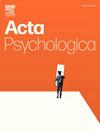将外语课堂焦虑与泰国学生的汉语成功联系起来
IF 2.7
4区 心理学
Q2 PSYCHOLOGY, EXPERIMENTAL
引用次数: 0
摘要
霍维茨外语课堂焦虑量表(FLCAS)是最常用的外语课堂焦虑调查量表。不同的文化背景和不同的分析方法导致了许多研究中FLCAS结构和相应项目的显著差异。本研究旨在重新检视泰国高中中文课堂课堂焦虑量表的建构,进而建立一个基于课堂焦虑量表的泰国高中生中文课堂焦虑量表模型。首先,将曼谷附近6所学校的810名学生分为两个样本进行探索性因子分析(EFA)和验证性因子分析(CFA)。之后,研究人员对两个样本进行了重新组合,分析了子构念与HSK分数在性别和汉语学习经历方面的差异,以及每个构念与其他子构念和学生HSK分数之间的相关关系。得到一个四因素模型,只保留了19个问题项。结果表明,FLCAS子构念在性别间无显著差异,但在汉语学习经历间存在显著差异。然而,HSK分数在性别和汉语学习经历方面存在显著差异。最后,FLCAS的四个子构之间呈正相关,但与HSK分数呈负相关。本文章由计算机程序翻译,如有差异,请以英文原文为准。
Bridging foreign language classroom anxiety to Thai students' Chinese language success
Horwitz's Foreign Language Classroom Anxiety Scale (FLCAS) is the most frequently used scale for investigating learners' anxiety in the foreign language classroom. Variations in cultural contexts and divergent analytical methods have resulted in notable differences in the FLCAS constructs and corresponding items across numerous studies. This study primarily sought to re-examine the constructs of the FLCAS in Thai high school Chinese classrooms and, in turn, to develop a model for measuring Thai high school students' Chinese classroom anxiety based on the FLCAS. First, 810 students from six schools around Bangkok were divided into two samples for exploratory factor analysis (EFA) and confirmatory factor analysis (CFA). After that, the researchers re-combined the two samples to analyze how the sub-constructs and HSK scores vary by gender and Chinese learning experience, as well as how each construct correlates with the other sub-constructs and the students' HSK scores. A four-factor model was obtained, retaining only nineteen question items. The results showed that FLCAS sub-constructs did not differ significantly between genders but did differ significantly with Chinese learning experience. HSK scores, however, differed significantly by both gender and Chinese learning experience. Lastly, the four sub-constructs of FLCAS are positively correlated with each other but negatively correlated with HSK scores.
求助全文
通过发布文献求助,成功后即可免费获取论文全文。
去求助
来源期刊

Acta Psychologica
PSYCHOLOGY, EXPERIMENTAL-
CiteScore
3.00
自引率
5.60%
发文量
274
审稿时长
36 weeks
期刊介绍:
Acta Psychologica publishes original articles and extended reviews on selected books in any area of experimental psychology. The focus of the Journal is on empirical studies and evaluative review articles that increase the theoretical understanding of human capabilities.
 求助内容:
求助内容: 应助结果提醒方式:
应助结果提醒方式:


